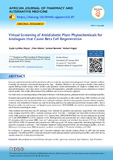Virtual Screening of Antidiabetic Plant Phytochemicals for Analogues that Cause Beta Cell Regeneration

View/
Date
2024-08-08Author
Kyalo, Cynthia Wayua
Otieno, Filex
Munene, Samuel
Kagia, Richard Kagia
Metadata
Show full item recordAbstract
Immune-mediated destruction of functional beta-cell mass is the key mechanism for pathogenesis of type 1 diabetes mellitus.
Currently, the mainstay conventional treatment for Type 1 Diabetes Mellitus is use of exogenous insulin. These patients
require lifelong insulin therapy which includes daily parenteral insulin administration, by single or multiple doses. Some
plant phytochemicals have been shown to cause beta cell regeneration, gradually restoring insulin production in diabetic
animal models. This would shift treatment from palliative care to more of curative approach.
this study aimed at screening analogs of these phytochemicals with better potency, pharmacokinetic and toxicological profiles.
Genistein and quercetin plant phytochemicals were selected to be screened by in-silico study design. ZINC database was used
to obtain analogues, then top 20 selected for each, totaling 40 analogues, all which were prepared using the software Avogadro.
Autodock vina embedded in Chimera was used for docking analysis at the epidermal growth factor receptor (erB1). Biovia
Discovery studio was used to carry out ligand-enzyme interactions. SWISSADME was used for pharmacokinetic profiling
and Protox for toxicological studies.
Three hundred and forty-four and 365 analogues were obtained for genistein and quercetin, respectively, with similarity
scores ranging from 99.6%-100%. Genistein (docking score= -6.0) had 12 analogues that were better in terms of docking
scores while quercetin had 5(docking score= -6.5). Among these, ZINC000038418848 was the best analogue for genistein
(-6.7) and ZINC000004731234 for quercetin (-6.8). Both genistein and quercetin did not violate Lipinski rules, had high
GI absorption, didn’t permeate BBB, were not P-glycoprotein substrates and inhibited the enzymes CYP1A2, CYP2D6
and CYP3A4. LD50 for genistein and quercetin was 2500 mg/kg and 159 mg/kg respectively, indicating high toxicity for
quercetin compared to genistein. Their analogues displayed similar pharmacokinetic and toxicological profiles, with few
differences in docking scores, BBB permeation, synthetic accessibility, CYP enzyme inhibition and LD50.
In conclusion, 12 genistein analogues and 5 quercetin analogues had stronger binding affinity to erB1 than the parent
compounds. The different ZINC compounds displayed varied pharmacokinetic and toxicological profiles, with a few having
superior properties to their parent compounds.
Collections
- Staff Collection [24]
